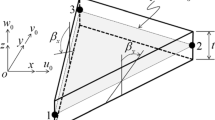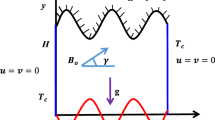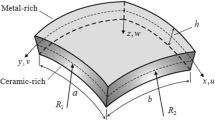Abstract
Classical treatment for the analysis of creep stresses and strain rates uses the assumptions of material incompressibility, infinitesimally small creep deformation, creep strain laws, associated flow rule, and yield criterion that simplify the complexity of the problem in the theory of creep deformation. However, other materials cannot be treated with classical treatment such as compressibility effect in creep and transition stresses in creep. Seth developed the theory of creep transition which requires no assumptions, and this theory is important for evaluating creep transition stresses and for treating compressibility effect in creep based on Lebesgue strain measure. In this research paper, creep transition stresses and strain rates in a spherical shell of isotropic or transversely isotropic materials under a thermal gradient and uniform pressure are derived using the transition theory of Seth and the generalized strain measure theory. Results are obtained in non-dimensional quantities and are shown graphically and illustrated numerically. It is observed that the value of circumferential stress for spherical shell made of isotropic material is higher than the value of circumferential stress for spherical shell made of transversely isotropic material at a high temperature for both measures on the internal surface. The values of circumferential strain rate increase significantly as the measure increases for the spherical shell made of isotropic material at the internal surface. It is concluded that a spherical shell subjected to a higher radial temperature gradient and a pressure made of transversely isotropic material is on the safer side of the design compared to the cylinder made of isotropic material for lower measure. The findings of this paper can be used to analyze and design a spherical shell structure such as rapid centrifugal separators, gas turbines for high control flying machine motors, turning satellite structures, and other rotor systems.



Similar content being viewed by others
REFERENCES
J. Chakrabarty, Applied Plasticity (Springer-Verlag, New York, 2000).
Y. C. Fung, Foundations of Solid Mechanics (Prentice-Hall, 1965).
I. S. Sokolinikoff, Mathematical Theory of Elasticity, 2nd ed. (McGraw – Hill Book Co., New York, 1956).
S. P. Timoshenko and J. N. Goodier, Theory of Elasticity, 3rd ed. (McGraw – Hill Book Co., New York, 1951).
G. E. Dieter, Jr., Mechanical Metallurgy (McGraw-Hill Book Co., 1961).
etals Handbook (ASM, Cleveland, 1939)
E. Reuss, “Reruecksichtigung der elastischen Formaenderungen in der Plastizitaets theorie,” Z. Angew. Math. Mech. 10, 266–274 (1930).
R. Hill, Mathematical Theory of Plasticity (Clarendon Press, Oxford, 1950).
E. Reissner, “Stress and small displacements of shallow spherical shells,” J. Math. Phys. 25(3), 80–85 (1946). https://doi.org/10.1002/sapm194625180
A. E. Johnson and B. Khan, “Creep of metallic thick-walled spherical vessels subject to pressure and radial thermal gradient at elevated temperatures,” Int. J. Mech. Sci. 5, 507–532 (1963). https://doi.org/10.1016/0020-7403(63)90032-8
W. Johnson and M. G. Derrington, “The onset of yield in a thick-spherical shell subject to internal pressure and uniform heat flow,” Appl. Sci. Res. Sec. A 7, 408–420 (1958). https://doi.org/10.1007/BF03184964
G. K. Miller, “Stresses in a spherical pressure vessel undergoing creep and dimensional changes,” Int. J. Solids Struct. 32 (14), 2077–2093 (1995). https://doi.org/10.1016/0020-7683(94)00197-5
M. D. Kashkoli and M. Z. Nejad “Time-dependent thermo-elastic creep analysis of thick-walled spherical pressure vessels made of functionally graded materials,” J. Theor. Appl. Mech. 53 (4), 1053–1065 (2015). https://doi.org/10.15632/jtam-pl.53.4.1053
R. W. Bailey, “Creep relationships and their applications to pipes, tubes and cylinder parts under internal pressure,” Proc. Inst. Mech. Eng. 164 (1), 1–131 (1951). https://doi.org/10.1243/PIME_PROC_1951_164_046_02
J. Marthelot, F. L. Jimenez, A. Lee, et al., “Buckling of a pressurized hemispherical shell subjected to a probing force,” J. Appl. Mech. 84 (12), 121005 (2017). https://doi.org/10.1115/1.4038063
S. M. Abo-Dahab, S. Z. Rida, R. A. Mohamed, et al., “Rotation, initial stress, gravity and electromagnetic field effect on P wave reflection from stress-free surface elastic half-space with voids under three thermoelastic models,” J. Mech. Mech. Eng. 22 (1), 313–328 (2018).
S. M. Abo-Dahab, A. A. Kilany, Allam, et al., “Influence of several fields on rayleigh waves propagation in a fiber-reinforced orthotropic half-space material under four thermoelastic models,” Waves Rand. Compl. Media (2020). https://doi.org/10.1080/17455030.2020.1849865
B. R. Seth, “Transition theory of elastic-plastic deformation, creep and relaxation,” Nature 195, 896–897 (1962).
B. R. Seth, “Measure concept in mechanics,” Int. J. Non-Lin. Mech. 1 (2), 35–40 (1966). https://doi.org/10.1016/0020-7462(66)90016-3
S. K. Gupta and R. L. Dharmani, “Creep transition in thick-walled cylinder under internal pressure,” Z. Angew. Math. Mech. 59, 517–521 (1979). https://doi.org/10.1002/zamm.19790591004
G. Verma, R. Puneet, D. S. Pathania, et al., “Creep transition in the rotating spherical shell under the effect of density variable by Seth’s transition theory,” AIP Conf. Proc. 1802, 020020 (2017). https://doi.org/10.1063/1.4973270
D. S. Pathania and G. Verma, “Temperature and pressure dependent creep stress analysis of spherical shell,” Int. J. Appl. Mech. Eng. 24 (1), 105–115 (2019). https://doi.org/10.2478/ijame-2019-0007
S. Sanjeev, S. Richa, and P. Rekha, “Creep transition in transversely isotropic composite circular cylinder subjected to internal pressure,” Int. J. Pure Appl. Math. 120 (1), 87–96 (2018).
B. R. Seth, “Elastic-plastic transition in shells and tubes under pressure,” Z. Angew. Math. Mech. 43, 345–51 (1963). https://doi.org/10.1002/zamm.19630430706
B. R. Seth, “Transition condition: the yield condition,” Int. J. Non-linear Mech. 5, 279–285 (1970). https://doi.org/10.1016/0020-7462(70)90025-9
A. G. Temesgen, S. B. Singh, and T. Pankaj, “Creep transition analysis in functionally graded thick-walled rotating transversely isotropic cylinder under a radial temperature gradient and uniform pressure,” Struct. Integrity Life 20 (3), 285–296 (2020).
A. G. Temesgen, S. B. Singh, and T. Pankaj, “Modeling of creep deformation of a transversely isotropic rotating disc with a shaft having variable density and subjected to a thermal gradient,” Thermal Sci. Eng. Progr. 20, 100745 (2020). https://doi.org/10.1016/j.tsep.2020.100745
A. G. Temesgen, S. B. Singh, and T. Pankaj, “Elastoplastic analysis in functionally graded thick-walled rotating transversely isotropic cylinder under a radial temperature gradient and uniform pressure,” Math. Mech. Solids 26 (1), 5–17 (2020). https://doi.org/10.1177/1081286520934041
P. Thakur, M. Sethi, N. Kumar, et al., “Analytical solution of hyperbolic deformable disk having variable density,” Mech. Solids 56 (6), 1039–1046 (2021). https://doi.org/10.3103/S0025654421060194
K. Gupta, P. Thakur, and R.K. Bhardwaj, “Elasto-plastic stress analysis in a tube made of isotropic material and subjected to pressure and mechanical load,” Mech. Solids (in press).
S. Hulsurkar, “Transition theory of creep of shells under uniform pressure,” Z. Angew. Math. Mech. 46, 431–437 (1966). https://doi.org/10.1002/ZAMM.19660460704
H. Parkus, Thermo-Elasticity (Springer, New York, 1976).
Author information
Authors and Affiliations
Corresponding authors
About this article
Cite this article
Temesgen, A.G., Singh, S.B. & Pankaj, T. Modeling of Creep Deformation in an Internally Pressurized Transversely Isotropic Spherical Shell Subjected to a Thermal Gradient. Mech. Solids 57, 937–948 (2022). https://doi.org/10.3103/S0025654422040185
Received:
Revised:
Accepted:
Published:
Issue Date:
DOI: https://doi.org/10.3103/S0025654422040185




